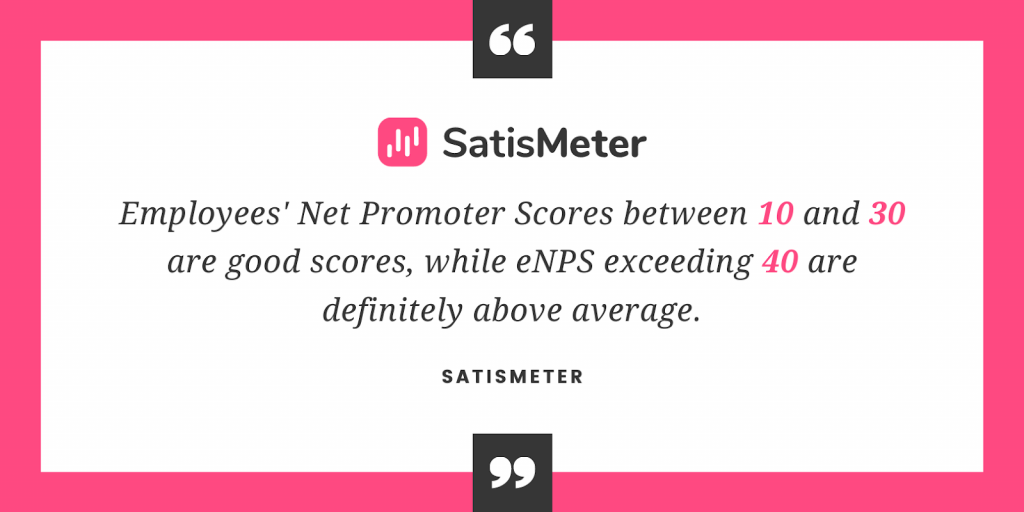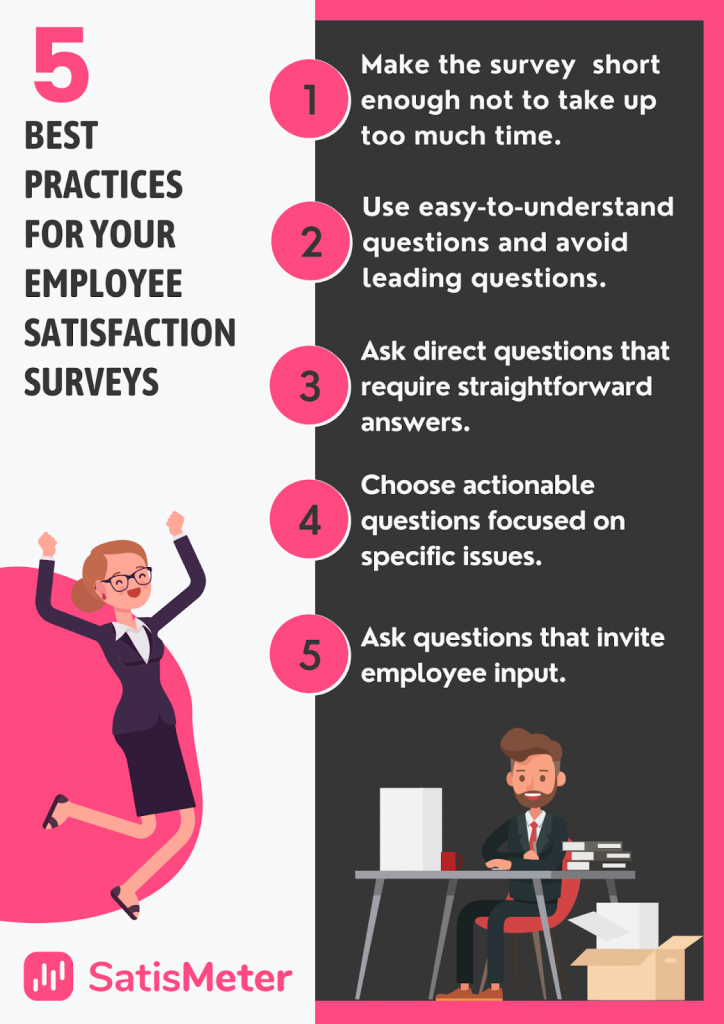In this article, we’re looking into employee satisfaction, what drives it, and how it can help your company succeed.
What is Employee Satisfaction?
The term employee satisfaction may sound simple. It’s how happy your employees are with their jobs and their workplace.
However, employee satisfaction is a little more complex than it seems. And it involves several different aspects.
How satisfied your employees are is influenced by elements like:
- how meaningful they find their jobs to be
- how fulfilled and engaged they feel in their activity
- their salary level and other compensations
- their relationship with the company or team management
- their workload
- the resources available to them
- work flexibility
Another complex aspect of employee satisfaction is that, while you can use employee satisfaction surveys or other methods to measure it, no two people among groups of employees will be satisfied by the same thing.
Some may be more motivated by the meaningfulness of their tasks and the overall company mission and vision statement. Others are more motivated by the financial aspect of the job. While others may put most of the emphasis on how motivating and challenging, or positive their work environment is.
Still, while knowing exactly what makes each employee happy is an intricate task, there are ways to determine whether or not your company culture and the environment overall manage to foster employee satisfaction and engagement.
We know that employee satisfaction plays a significant role in a company’s productivity levels, staff turnover rates, and revenue. And therefore, its success.

Why is Employee Satisfaction Important?
Research shows that the number one advantage of employee satisfaction is that it drives employee engagement.
Employee engagement is how committed employees are to their job and their company and how much effort they are willing to put in to achieve their tasks and goals.
Happy employees perform better, are more committed to and engaged in their tasks and duties, and deliver better results. They are also more likely to stay with your organization for longer and be more loyal.
For your company’s success, employee satisfaction translates into:
- higher levels of innovation
- less employee absenteeism and more engagement
- a better workplace culture
High levels of employee satisfaction and engagement ultimately lead to:
- increased productivity levels
- lower employee turnover rates
- higher levels of valuable employee retention
- better quality for your product or service
- increased customer satisfaction levels
To conclude, employee satisfaction and, ultimately, employee engagement contribute to a company’s success by:
- retaining talented employees
- motivating them to deliver their best and to be part of the company’s growth
- increasing the company’s potential for development.
How to Measure Employee Satisfaction
Now that we’ve gone through why employee satisfaction is essential, let’s look at your options for measuring it.
Employee satisfaction surveys
We can split the most popular employee satisfaction surveys into two types:
- employee net promoter score (eNPS)
- traditional satisfaction surveys.
These employee satisfaction surveys can give you valuable data on how happy your employees are and what organizational aspects you can work on to improve their overall job satisfaction and engagement.

Employee Net Promoter Score
Employee Net Promoter Score surveys have the benefit of being very easy to answer. Therefore, they have high response rates. They are similar to NPS surveys used for measuring customer satisfaction but adapted for measuring employee satisfaction instead.
ENPS aims mainly to answer how likely employees are to recommend a workplace to others, be it their family, friends, or acquaintances.
You can also choose to supplement the central question of your eNPS with additional questions. You can ask things like what employees most appreciate about your company. Or what they dislike or would like to change.
To calculate your eNPS score, we refer as promoters to employees responding with a 9 or a 10 (from a scale of 1 to 10). Employees responding with a 7 or 8 are considered neutral. At the same time, any person answering from 0 to 6 is viewed as a detractor.
Your company’s eNPS score will be the total number of promoters minus the detractors. In general, scores between 10 and 30 are good eNPS scores, while scores exceeding 40 are above average.
The main disadvantage of eNPS surveys is that while they give you important data about how satisfied your employees are overall, they won’t give you much information on what specific aspects require improvement.
This is why many companies choose to supplement their eNPS questions with additional questions that may provide more details about what employees would like to see changed or choose traditional surveys instead.
As for the frequency, you should use eNPS at least twice a year or even every quarter to evaluate employee satisfaction levels.
Traditional employee satisfaction surveys
The main advantage of traditional employee satisfaction surveys is that they can be tailor-made to measure specific aspects of your company that employees are satisfied with or not.
The key to getting answers you can get the best use of is to know what you are targeting. Otherwise, because these types of surveys allow you to add how many questions you want, you risk getting many answers but little valuable data.
The best practices when it comes to employee satisfaction surveys are:
1. Make the survey long enough to give you the data you need but short enough not to take up too much time.
2. Use easy-to-understand questions and avoid leading questions.
3. Ask direct questions that require straightforward answers.
4. Choose actionable questions focused on specific issues.
5. Ask questions that invite employee input.
Here are some aspects you can focus your employee engagement survey questions on:
- Company culture (how positive the environment is, how included employees feel)
- Company goals (how engaged employees feel in achieving these goals, how is their current sense of purpose)
- Personal goals (what motivates employees – salary, benefits, additional resources, career opportunities)
- Relationship with the management (how motivated employees feel by the company or team management, how they would rate communication and employee morale)
- Coworker interaction (how well employees communicate and relate to other team members)
Employee meetups
If you prefer a more direct approach, you can ask the same types of questions and get the same answers about employee satisfaction levels by meeting them. Whether face-to-face or via different meeting platforms.
Asking about employee experience in a more informal but still professional setting can help you get valuable answers. You can do this by organizing:
- individual interviews (aka stay interviews)
- small group meetings
- company-level meetings.
You can choose which type of employee satisfaction measurement method works best for your company’s culture. However, the one thing that all solutions for measuring employee satisfaction have in common is that they must lead to concrete actions.
Once you get the employee satisfaction data, you must be ready to implement the required changes to the work environment.

How to Improve Employee Satisfaction
Measuring employee satisfaction levels is only half of the job. The second one is how you choose to improve them.
Luckily, there are several ways you can increase employee satisfaction and engagement. All of which are sure to drive employee satisfaction levels up.
Use your employee satisfaction survey data wisely
The first step in putting employee satisfaction survey data to good use is to compare it to previous data. If the current results are more favorable than the last survey, it’s a good indication that you should continue any changes you have started implementing.
On the other hand, if you don’t have any previous survey data, your first step should be to thoroughly analyze the data obtained from your current employee satisfaction survey.
This way, you can identify key problem areas (if any) and the key positive aspects employees have pinpointed in their answers. Both will give you a good indication of where you need to start implementing or continuing changes.
Implement innovative solutions for driving engagement and results
All employees appreciate knowing what they have to do and what their role in an organization is. Employee engagement can drop significantly when they do not understand what is expected of them and what end goal they are working towards.
Fortunately, the solutions accessible to managers nowadays to keep the company activity on track, assign and monitor task performance are almost endless. These innovative tools can help you set clear goals and expectations and easily track progress.
One such tool you can use is Weekdone. This complex team management software can help you:
- lead and guide teams
- set and measure objectives
- track progress
- plan and schedule tasks.
On top of this, it has integrated a One-on-One Chat feature and Pulse Survey options to help you better understand what issues your team may be facing and what their mindset is.
Offer more of what employees want
Your employee satisfaction survey data should be able to tell you what the top motivators are for your teams. Especially if your employee survey questions include questions like ‘What do you most appreciate about your job/the company’, pinpointing the main driving factors should be easy.
The same goes if you’ve asked employees to describe what they dislike about their place of work.
It could be that your employees appreciate your flexible schedules allowing them to get a better work-life balance. It could be more competitive salaries or more benefits. Or, it could be the company culture and overall positive environment that keeps them motivated and engaged.
No matter what it is, it’s critical that once you’ve identified what works for your employees, you make this information work for them as well as for you. Use the data you collected from the employee satisfaction survey to set up clear goals and plans to improve employee engagement.
Reward good work
Rewarding employees for a job well done is paramount in maintaining high employee satisfaction levels. Employees are more motivated to give their all to performing a task or their job when they know that you have noticed and appreciated their hard work. This effort will pay back and contribute to the company’s growth.
Although these rewards usually come in benefits or financial incentives, positive feedback can also do a great job of motivating employees and keeping them engaged. It’s because more employees than you can imagine complain that their hard work has not been recognized in any shape or form.
Hard-working employees want to feel valued and appreciated, and they want to know that their commitment is respected.
Offer more growth opportunities
Employees value jobs that offer career development and growth opportunities.
Be it the opportunity to move up in the company, benefit from additional training or education, or more responsibility, employees appreciate jobs that allow them to grow and feel like they are progressing.
In the end, offering employees more growth opportunities will help your company’s success. That is because you will benefit from the work of better trained and more motivated employees.
Encourage feedback
Employees are more likely to be open and sincere when answering employee satisfaction survey questions if they are already accustomed to providing and receiving regular feedback.
On the other hand, simply encouraging feedback is not enough. Employees need to see that the feedback they provide turns into visible results. And that their opinion is appreciated enough to lead to actionable change.
At the same time, you should also encourage managers to provide feedback on employee performance and set up one-on-ones to help both parties address common challenges and goals and identify solutions for moving forward.
About the author
